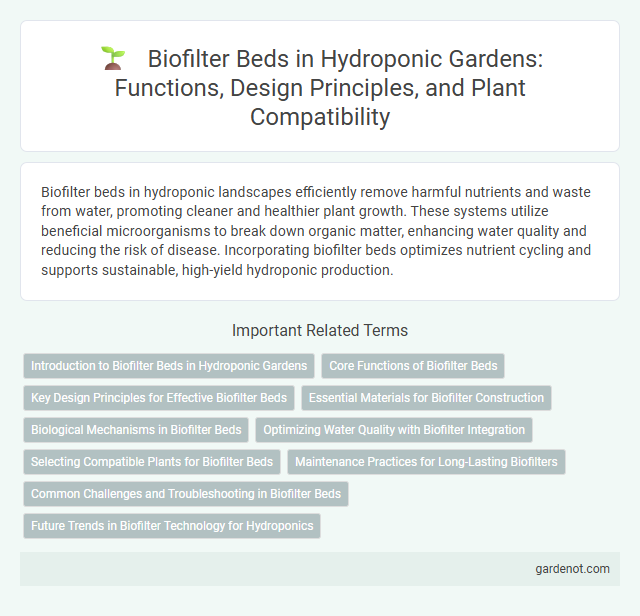Biofilter beds in hydroponic landscapes efficiently remove harmful nutrients and waste from water, promoting cleaner and healthier plant growth. These systems utilize beneficial microorganisms to break down organic matter, enhancing water quality and reducing the risk of disease. Incorporating biofilter beds optimizes nutrient cycling and supports sustainable, high-yield hydroponic production.
Introduction to Biofilter Beds in Hydroponic Gardens
Biofilter beds in hydroponic gardens serve as natural filtration systems that utilize beneficial microbes to break down organic waste, improving water quality and nutrient availability. These beds are designed with porous media like gravel or lava rock, which provide surface areas for microbial colonies to thrive and convert harmful substances into bioavailable nutrients for plants. Integrating biofilter beds enhances system sustainability by promoting healthier root zones and reducing the risk of toxic buildup in recirculating hydroponic systems.
Core Functions of Biofilter Beds
Biofilter beds play a critical role in hydroponic landscapes by removing organic waste and harmful nitrates through microbial activity, enhancing water quality and plant health. These beds facilitate nitrification and denitrification processes, converting toxic ammonia into harmless nitrogen gas, thereby preventing nutrient imbalances and root damage. Efficient biofilter beds also support oxygenation and maintain optimal pH levels in recirculating hydroponic systems, promoting sustainable plant growth and system stability.
Key Design Principles for Effective Biofilter Beds
Key design principles for effective biofilter beds in hydroponic landscapes include optimizing the media composition to maximize surface area for microbial colonization, ensuring proper hydraulic retention time to allow sufficient nutrient filtration, and maintaining adequate oxygenation to support aerobic microbial activity. Selecting inert, porous materials like expanded clay or lava rock enhances biofiltration efficiency by facilitating beneficial bacteria growth. Incorporating a multi-layer system with gradual flow control prevents clogging and promotes uniform water distribution, critical for sustainable pollutant removal.
Essential Materials for Biofilter Construction
Essential materials for biofilter construction in hydroponic landscapes include porous substrates such as expanded clay pellets, volcanic rock, and coconut coir, which provide ample surface area for microbial colonization. Durable frameworks made from plastic or stainless steel ensure structural integrity and resistance to water and nutrient exposure. Incorporating activated carbon or zeolite enhances filtration efficiency by adsorbing harmful contaminants and balancing pH levels within the biofilter bed.
Biological Mechanisms in Biofilter Beds
Biofilter beds utilize microbial communities to biologically degrade organic pollutants and convert harmful nitrogen compounds into less toxic forms through nitrification and denitrification processes. These biological mechanisms are driven by aerobic and anaerobic bacteria that colonize the substrate, optimizing nutrient cycling and improving water quality in hydroponic systems. Effective biofilter beds maintain balanced microbial populations to enhance system sustainability and plant health.
Optimizing Water Quality with Biofilter Integration
Biofilter beds play a crucial role in optimizing water quality within hydroponic landscapes by efficiently removing harmful nitrates and organic compounds through microbial activity. Integrating biofilter systems enhances nutrient cycling and stabilizes pH levels, creating an ideal environment for plant growth. Consistent biofilter maintenance ensures sustained performance, reducing the risk of waterborne pathogens and improving overall system sustainability.
Selecting Compatible Plants for Biofilter Beds
Selecting compatible plants for biofilter beds in hydroponic landscapes enhances nutrient uptake and maximizes pollutant removal. Species such as water hyacinth, duckweed, and reed grass are effective due to their rapid growth and high tolerance to varying water conditions. Ensuring plant compatibility with system parameters like pH, light, and nutrient levels optimizes biofilter efficiency and sustains a balanced aquatic environment.
Maintenance Practices for Long-Lasting Biofilters
Regular monitoring and cleaning of biofilter beds are essential for maintaining optimal microbial activity and efficient nutrient removal in hydroponic landscapes. Replacing or replenishing the filter media periodically prevents clogging and supports consistent water flow, enhancing biofilter longevity. Incorporating proper aeration and avoiding chemical imbalances further sustain biofilter performance and extend operational lifespan.
Common Challenges and Troubleshooting in Biofilter Beds
Biofilter beds in hydroponic landscapes often face common challenges such as bio-clogging, which restricts water flow and reduces oxygen availability, and imbalance in microbial populations that can hinder nutrient cycling. Troubleshooting requires regular monitoring of water parameters like pH, dissolved oxygen, and nutrient levels, alongside periodic maintenance such as cleaning or replacing filter media to prevent accumulation of organic matter. Effective management ensures optimal biofilter performance, promoting healthier plant growth and sustainable hydroponic system function.
Future Trends in Biofilter Technology for Hydroponics
Future trends in biofilter technology for hydroponics emphasize enhanced microbial consortia to improve nutrient cycling and disease suppression. Integration of sensor-based monitoring systems enables real-time optimization of biofilter performance, increasing system efficiency and crop yield. Advancements in sustainable materials for biofilter media contribute to longer lifespan and reduced environmental impact in hydroponic landscape applications.
Biofilter bed Infographic

 gardenot.com
gardenot.com